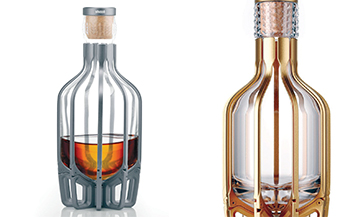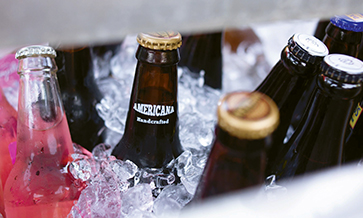Imagine a hot summer day; your customers want cool and refreshing drinks. What could be worse than having their expectations ruined by lukewarm beverages?
You could throw your stock into the freezer; but this throws up the question about how long should you have chilled your drink beforehand for it to have reached its optimal temperature?
To resolve this compelling problem, Poland-based OmniCalculator has designed a chilled-drink calculator for science to give you the proper answer.
This article talks about the ideal serving temperature of different beverages and how our ancestors cooled their drinks in the past.
Scientists have discovered that beverage intake on different temperatures could fulfil different purposes, at the most. For example, experiments have shown that on a hot, dry day, drinking a hot beverage may cool your body better than a cold drink!
But when the ultimate goal is to quench your thirst as fast as possible, a recent study shows cold and carbonated beverages might be the best choice. This finding coincides with other surveys which prove that the sensation in the mouth plays a crucial role in satiating thirst.
However, we rely prominently on the historically-evolved serving habits that reflect the specific qualities of different drinks. Due to their diverse chemical structures, the temperature at which one will enjoy a drink the most will differ from beverage to beverage.
Wines
There is probably no other type of drink where the right temperature is so crucial. As a general rule, it is best to serve white and rosé wines at a cold temperature, around 9-13°C.
This causes the acidity of the wines to become more pronounced and the wine will be fresher, with a lighter taste. When it is too warm, the alcohol becomes dominant, leading to a harsh taste.
However, over-chilling may result in the wine losing its flavour entirely. White wines that contain high residual sugar, such as ice wines or Tokaji Aszú wines, are best served at 10-12°C.
Red wines are best served at room temperature; but the question is ‘What is room temperature?’ The expression dates back to medieval Europe, where it was much more difficult to control the temperature of a house.
As a result, our ancestors had to bear a lower indoor temperature, around 15-18°C. Incidentally, it is this temperature that best shows the fragrance of red wines, while also showing off the grape’s balanced taste and fruitiness!
Sparkling wines and Champagne are the drinks that require refrigeration the longest if you want to enjoy them the most. Their optimal drinking temperature is 8-10°C, with sweet aromatic sparkling wines requiring a temperature as low as 7°C.
Beers
If you envisage a bottle of beer on a hot summer day, you may associate it with super-cool refreshment. However, depending on the type of beer and its qualities, the precise serving temperature may differ widely.
As a basic rule, no beer should be served below 6°C as ice-cold temperature dampens its flavour.
Though your customers might enjoy a lager at the lowest temperature (6-9°C), it is better to imbibe a somewhat warmer ale that is around 7-11°C. If you prefer stout, you know that cellar temperature is the best choice, that being around 13°C.
Sodas
The situation is far less complicated with soda or carbonated drink: you will experience its full flavour at any temperature. We suggest that carbonated beverages are best enjoyed at around 4-5°C.
Manufacturers recommend that their respective products be drunk at slightly different temperatures, ranging from 5.5°C to 3.3°C.
Water
The jury is still out when it comes to water: your body can benefit from different temperatures, depending on your taste and circumstances. As the ultimate purpose of water intake is hydration, we would suggest the event that fulfils this function the most.
Studies suggest that you can reach the optimum level of hydration if you ingest your water at around 16°C. Still, as we have mentioned, other studies imply that cold and carbonated water is a better choice when you aim to quench your thirst.
Juices
Juices are best served cold – and yet it is better not to cool them to below 12°C, as they may lose their sweet fruity taste. The perfect temperature for juices is between 12-15°C.
Liquor
Although some spirits, such as brandy or whiskey, are best experienced at room temperatures other drinks, like vodka and gin, are traditionally consumed cold.
When you chill them, they get a little viscous, helping mask some of their alcoholic harshnesses. However, it better not to store good quality vodka or gin in the freezer as it will lose all its flavours.
Cream liqueurs should be kept in the fridge as the cold can balance the high sugar content they commonly have. The best temperature to serve them is 0-4°C.
Calculator
Despite appearances, the OmniCalculator makes use of the physics of chilling. It is an easy-to-use version of Newton’s law of cooling that has been modified to include technical values for the most common combinations of containers and beverages.
The chilled drink calculator aims to work out the time a beverage requires refrigeration (or another cool place) to reach its optimal drinking temperature. Aimed at providing a more comprehensive service, the platform is designed in such a way that you can choose other pre-defined temperatures, or even set the desired temperature yourself!
To begin the calculation, the following steps have to be followed:
- Choose one of the beverages specifically identified;
- Specify its volume, as this also affects the cooling process;
- You may choose between three default settings, or you can set it manually;
- Select the place where you would like to chill your drink;
- Keep in mind that the temperature of this spot should be colder than both the initial and the optimal temperature of your beverage;
- By default, the desired temperature is the drink’s optimal temperature.
However, this is only a default setting that can still be customised to the desired temperature to fit your needs. After setting the above specifications, you will immediately get the time your drink requires to reach its desired temperature.
A dynamic chart has also been designed so that you can see how the temperature of your drink changes over time. This is useful if you want to quickly check the temperature of your drink after a specific time.
Other considerations
The optimal temperature for a particular drink may be different to that set out in this calculator, due to local customs, personal preference, or the drink’s specific qualities.
For brevity’s sake, we have focused solely on the most popular beverages and their typical temperatures. The estimation this calculator performs should only be taken as an approximate guide; its accuracy may be affected by imperfect input values and by external circumstances not incorporated in the computation process.
For instance, the number of bottles may affect the capacity of the fridge; or a slight deviation in the density or alcohol content of a drink may impact the chilling process.
Finally, for any alcoholic beverages, always drink responsibly and remember to stay hydrated, especially when the weather is hot and you are in the sun.
Although regular beers have relatively low alcohol content and are generally consumed in higher quantities than say, vodka, they still dehydrate your body.
For more information, check out www.omnicalculator.com/food/chilled-drink.














